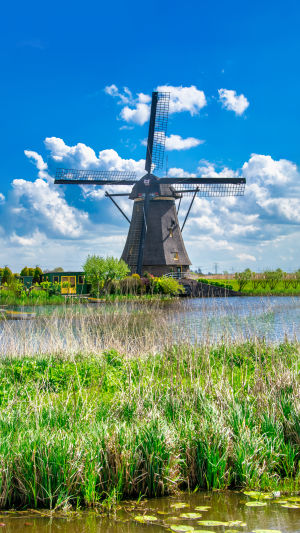Despite its small size, the Netherlands boasts a remarkable array of UNESCO World Heritage Sites, each telling a unique story of its rich cultural history, innovative architectural achievements, and ongoing battle with the sea.
This article explores the Dutch legacy preserved in these sites, from iconic windmills and historic canals to groundbreaking engineering projects.
<h3>Amsterdam Canal Ring</h3>
Amsterdam Canal Ring, known as the "Venice of the North," is a masterpiece of 17th-century architecture. Walking along these canals, you will be captivated by the classical buildings and picturesque waterways. The canals are not only an essential part of the city's transportation network but also a testament to its historical transformation. Visitors are encouraged to rent a small boat and leisurely explore these waterways, enjoying a unique perspective from the water.
Amsterdam Canal Ring, built in the 17th century, is one of the great engineering feats of the Dutch Golden Age. The Canal Ring comprises three main canals: Herengracht, Keizersgracht, and Prinsengracht. These canals form a unique urban landscape, semi-circularly encircling the city centre.
Strolling along the canals, visitors can admire the classical buildings on either side, many of which were homes to merchants and nobility. The canals are crossed by numerous beautiful bridges, with the "Seven Bridges View" being the most famous, offering a stunning sight when illuminated at night.
The Canal Ring is a vibrant cultural hub. Various concerts and art exhibitions are held here every summer, allowing visitors to enjoy the scenery while soaking in the rich cultural atmosphere.
Visitors can choose to take a canal cruise to enjoy the city’s beauty from the water. These cruises often come with professional guides who provide detailed stories about each historical site and building. Along the canals, there are also numerous cafes and restaurants where visitors can savour authentic Dutch cuisine and enjoy a leisurely time.
<h3>The Windmills of Kinderdijk</h3>
The windmills of Kinderdijk are a symbol of Dutch ingenuity in water management. Designed in the 18th century to prevent flooding, this ingenious network of windmills and water management systems is still operational today. The site features 19 windmills, each unique design and function, standing as a testament to the Netherlands' centuries-old battle with water. Visitors can explore the windmills and learn about their history and operation through guided tours and interactive exhibits.
<h3>Rietveld Schröder House in Utrecht</h3>
The Rietveld Schröder House, located in Utrecht, is an architectural masterpiece designed by Gerrit Rietveld in 1924. This house is considered one of the best examples of the De Stijl art movement and showcases a radical approach to design with its open-plan layout and use of primary colours. Visitors can tour the house to see the innovative use of space and learn about the philosophy behind its design.
<h3>Schokland and Surroundings</h3>
Schokland, once an island in the Zuiderzee, is now part of the mainland due to land reclamation projects. This historic site symbolizes the Netherlands' continuous struggle against the sea. The area is now an archaeological site with remnants of prehistoric human habitation and the remains of the medieval village of Schokland. Visitors can explore the museum and the preserved structures to get a glimpse into the life of the island’s former inhabitants.
<h3>Beemster Polder</h3>
The Beemster Polder is a perfect example of Dutch land reclamation techniques. Drained in the early 17th century, this area turned water into productive farmland. The geometric layout of fields, roads, canals, and settlements reflects the Dutch's advanced planning and engineering skills. Visitors can take a bike tour through the polder to appreciate the land's meticulous design and ongoing agricultural use.
The Netherlands' World Heritage Sites offer a unique insight into the country’s rich history, culture, and innovative spirit. From the bustling canals of Amsterdam to the tranquil windmills of Kinderdijk, each site tells a story of resilience and ingenuity. Exploring these heritage sites provides an opportunity to appreciate the diverse landscapes and historical treasures that make the Netherlands a fascinating destination.





